Evaluating Project Management Approaches for Fixed Bid Projects
VerifiedAdded on 2023/06/09
|13
|4047
|232
Project
AI Summary
This project examines the challenges and potential solutions for fixed bid projects within the context of Sri Lankan offshore software development companies. The research begins with an introduction outlining the background of fixed bid projects, the prevalence of project failures, and the research problem. The literature review defines key terms and explores relevant theories and empirical findings related to project management methodologies such as Waterfall and Six Sigma. The research methodology section outlines the conceptual framework, research questions, and the methods of data analysis. The project aims to identify the most suitable project management approaches for ensuring the success of fixed bid projects, considering factors such as communication, budgeting, and legal agreements. The study seeks to understand why fixed bid projects often fail and proposes strategies to improve their success rate, offering valuable insights for both clients and developers in the software industry.
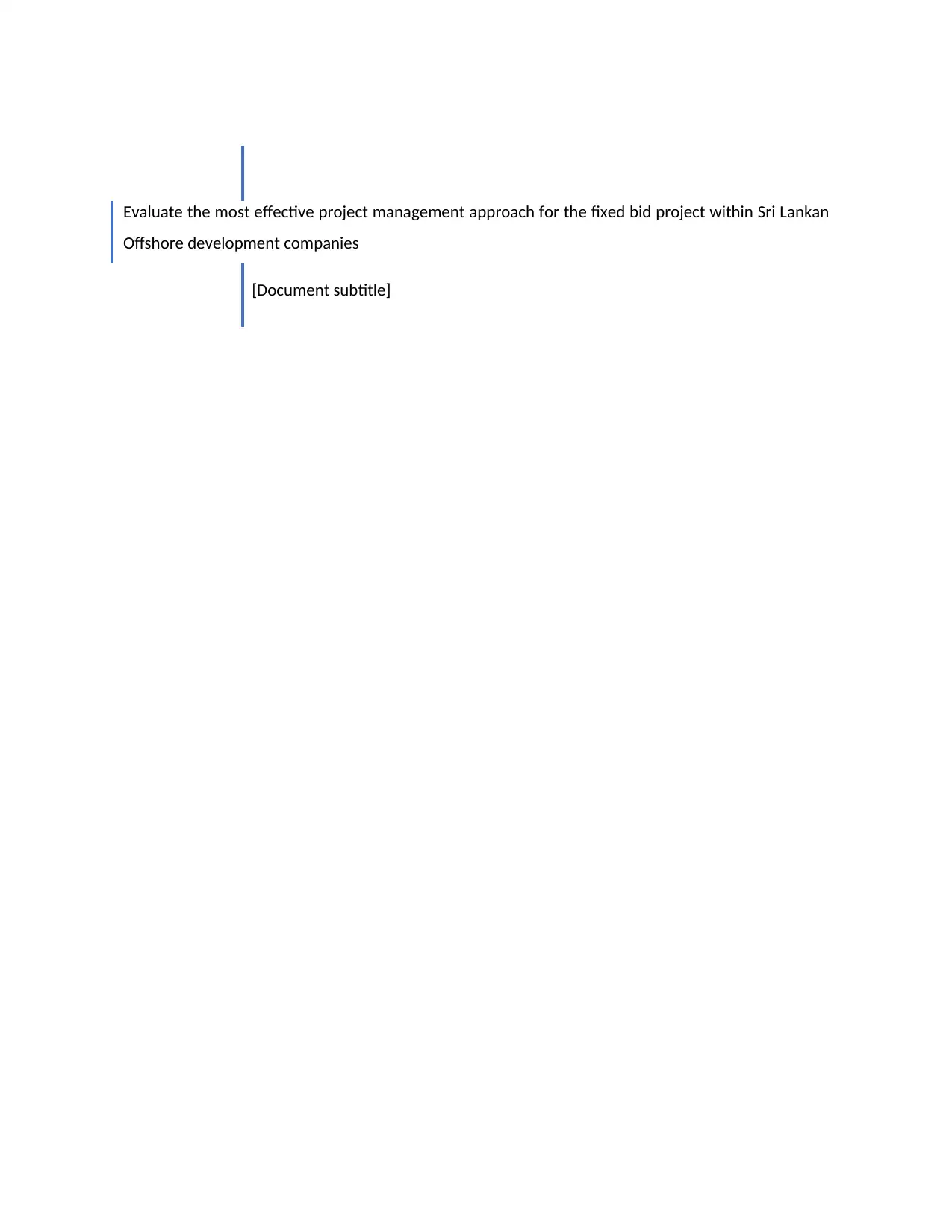
Evaluate the most effective project management approach for the fixed bid project within Sri Lankan
Offshore development companies
[Document subtitle]
Offshore development companies
[Document subtitle]
Paraphrase This Document
Need a fresh take? Get an instant paraphrase of this document with our AI Paraphraser
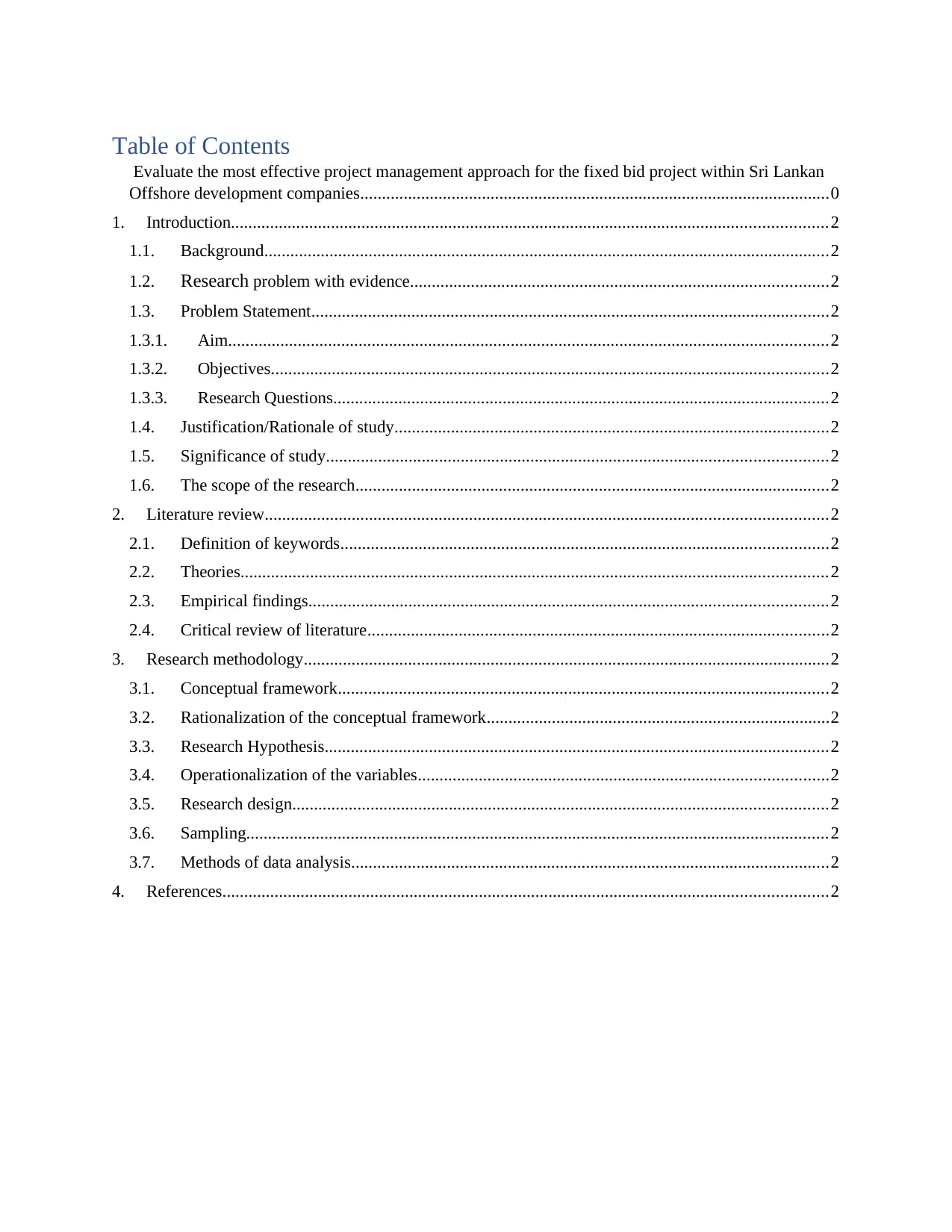
Table of Contents
Evaluate the most effective project management approach for the fixed bid project within Sri Lankan
Offshore development companies............................................................................................................0
1. Introduction.........................................................................................................................................2
1.1. Background..................................................................................................................................2
1.2. Research problem with evidence................................................................................................2
1.3. Problem Statement.......................................................................................................................2
1.3.1. Aim..........................................................................................................................................2
1.3.2. Objectives................................................................................................................................2
1.3.3. Research Questions..................................................................................................................2
1.4. Justification/Rationale of study....................................................................................................2
1.5. Significance of study...................................................................................................................2
1.6. The scope of the research.............................................................................................................2
2. Literature review.................................................................................................................................2
2.1. Definition of keywords................................................................................................................2
2.2. Theories.......................................................................................................................................2
2.3. Empirical findings.......................................................................................................................2
2.4. Critical review of literature..........................................................................................................2
3. Research methodology.........................................................................................................................2
3.1. Conceptual framework.................................................................................................................2
3.2. Rationalization of the conceptual framework...............................................................................2
3.3. Research Hypothesis....................................................................................................................2
3.4. Operationalization of the variables..............................................................................................2
3.5. Research design...........................................................................................................................2
3.6. Sampling......................................................................................................................................2
3.7. Methods of data analysis..............................................................................................................2
4. References...........................................................................................................................................2
Evaluate the most effective project management approach for the fixed bid project within Sri Lankan
Offshore development companies............................................................................................................0
1. Introduction.........................................................................................................................................2
1.1. Background..................................................................................................................................2
1.2. Research problem with evidence................................................................................................2
1.3. Problem Statement.......................................................................................................................2
1.3.1. Aim..........................................................................................................................................2
1.3.2. Objectives................................................................................................................................2
1.3.3. Research Questions..................................................................................................................2
1.4. Justification/Rationale of study....................................................................................................2
1.5. Significance of study...................................................................................................................2
1.6. The scope of the research.............................................................................................................2
2. Literature review.................................................................................................................................2
2.1. Definition of keywords................................................................................................................2
2.2. Theories.......................................................................................................................................2
2.3. Empirical findings.......................................................................................................................2
2.4. Critical review of literature..........................................................................................................2
3. Research methodology.........................................................................................................................2
3.1. Conceptual framework.................................................................................................................2
3.2. Rationalization of the conceptual framework...............................................................................2
3.3. Research Hypothesis....................................................................................................................2
3.4. Operationalization of the variables..............................................................................................2
3.5. Research design...........................................................................................................................2
3.6. Sampling......................................................................................................................................2
3.7. Methods of data analysis..............................................................................................................2
4. References...........................................................................................................................................2
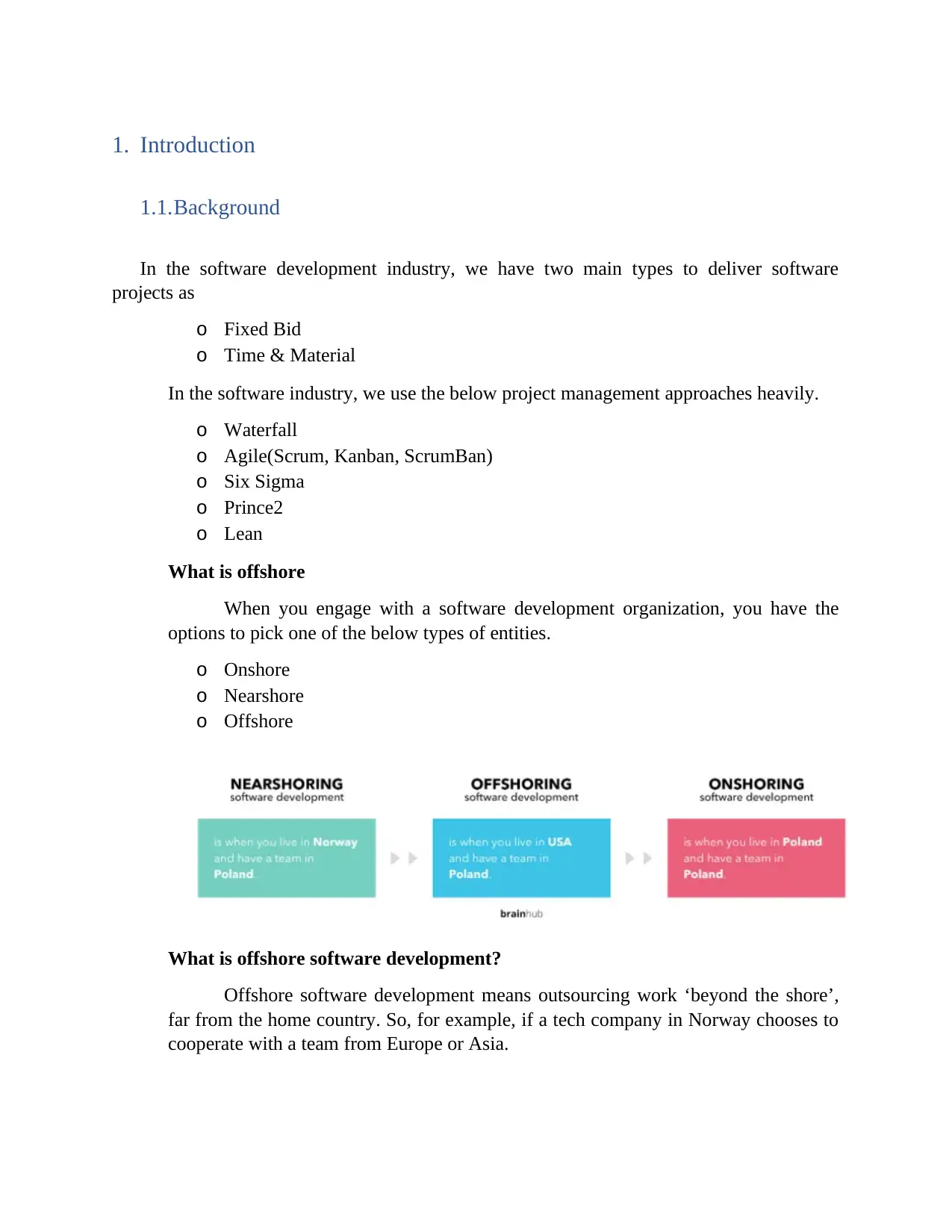
1. Introduction
1.1.Background
In the software development industry, we have two main types to deliver software
projects as
o Fixed Bid
o Time & Material
In the software industry, we use the below project management approaches heavily.
o Waterfall
o Agile(Scrum, Kanban, ScrumBan)
o Six Sigma
o Prince2
o Lean
What is offshore
When you engage with a software development organization, you have the
options to pick one of the below types of entities.
o Onshore
o Nearshore
o Offshore
What is offshore software development?
Offshore software development means outsourcing work ‘beyond the shore’,
far from the home country. So, for example, if a tech company in Norway chooses to
cooperate with a team from Europe or Asia.
1.1.Background
In the software development industry, we have two main types to deliver software
projects as
o Fixed Bid
o Time & Material
In the software industry, we use the below project management approaches heavily.
o Waterfall
o Agile(Scrum, Kanban, ScrumBan)
o Six Sigma
o Prince2
o Lean
What is offshore
When you engage with a software development organization, you have the
options to pick one of the below types of entities.
o Onshore
o Nearshore
o Offshore
What is offshore software development?
Offshore software development means outsourcing work ‘beyond the shore’,
far from the home country. So, for example, if a tech company in Norway chooses to
cooperate with a team from Europe or Asia.
⊘ This is a preview!⊘
Do you want full access?
Subscribe today to unlock all pages.

Trusted by 1+ million students worldwide
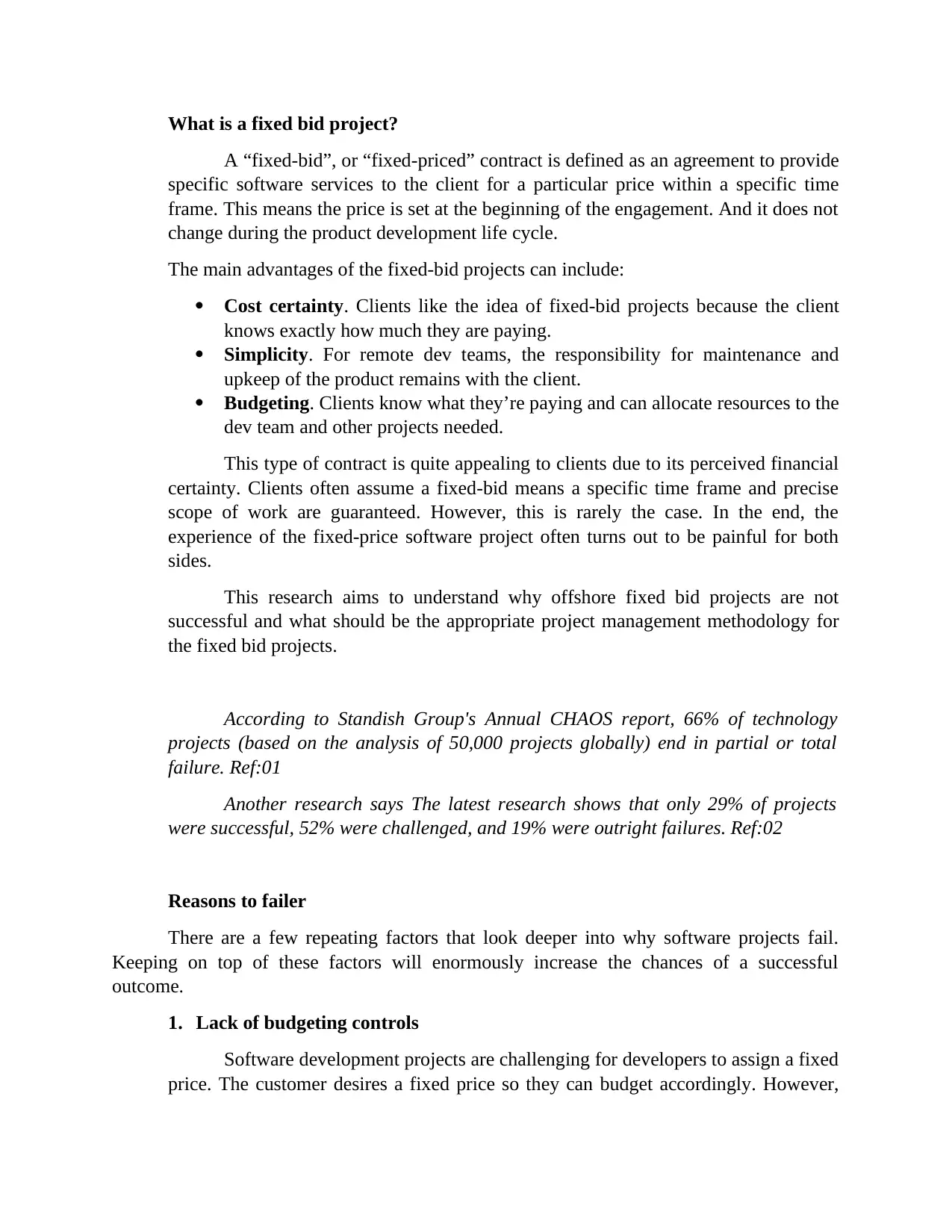
What is a fixed bid project?
A “fixed-bid”, or “fixed-priced” contract is defined as an agreement to provide
specific software services to the client for a particular price within a specific time
frame. This means the price is set at the beginning of the engagement. And it does not
change during the product development life cycle.
The main advantages of the fixed-bid projects can include:
Cost certainty. Clients like the idea of fixed-bid projects because the client
knows exactly how much they are paying.
Simplicity. For remote dev teams, the responsibility for maintenance and
upkeep of the product remains with the client.
Budgeting. Clients know what they’re paying and can allocate resources to the
dev team and other projects needed.
This type of contract is quite appealing to clients due to its perceived financial
certainty. Clients often assume a fixed-bid means a specific time frame and precise
scope of work are guaranteed. However, this is rarely the case. In the end, the
experience of the fixed-price software project often turns out to be painful for both
sides.
This research aims to understand why offshore fixed bid projects are not
successful and what should be the appropriate project management methodology for
the fixed bid projects.
According to Standish Group's Annual CHAOS report, 66% of technology
projects (based on the analysis of 50,000 projects globally) end in partial or total
failure. Ref:01
Another research says The latest research shows that only 29% of projects
were successful, 52% were challenged, and 19% were outright failures. Ref:02
Reasons to failer
There are a few repeating factors that look deeper into why software projects fail.
Keeping on top of these factors will enormously increase the chances of a successful
outcome.
1. Lack of budgeting controls
Software development projects are challenging for developers to assign a fixed
price. The customer desires a fixed price so they can budget accordingly. However,
A “fixed-bid”, or “fixed-priced” contract is defined as an agreement to provide
specific software services to the client for a particular price within a specific time
frame. This means the price is set at the beginning of the engagement. And it does not
change during the product development life cycle.
The main advantages of the fixed-bid projects can include:
Cost certainty. Clients like the idea of fixed-bid projects because the client
knows exactly how much they are paying.
Simplicity. For remote dev teams, the responsibility for maintenance and
upkeep of the product remains with the client.
Budgeting. Clients know what they’re paying and can allocate resources to the
dev team and other projects needed.
This type of contract is quite appealing to clients due to its perceived financial
certainty. Clients often assume a fixed-bid means a specific time frame and precise
scope of work are guaranteed. However, this is rarely the case. In the end, the
experience of the fixed-price software project often turns out to be painful for both
sides.
This research aims to understand why offshore fixed bid projects are not
successful and what should be the appropriate project management methodology for
the fixed bid projects.
According to Standish Group's Annual CHAOS report, 66% of technology
projects (based on the analysis of 50,000 projects globally) end in partial or total
failure. Ref:01
Another research says The latest research shows that only 29% of projects
were successful, 52% were challenged, and 19% were outright failures. Ref:02
Reasons to failer
There are a few repeating factors that look deeper into why software projects fail.
Keeping on top of these factors will enormously increase the chances of a successful
outcome.
1. Lack of budgeting controls
Software development projects are challenging for developers to assign a fixed
price. The customer desires a fixed price so they can budget accordingly. However,
Paraphrase This Document
Need a fresh take? Get an instant paraphrase of this document with our AI Paraphraser
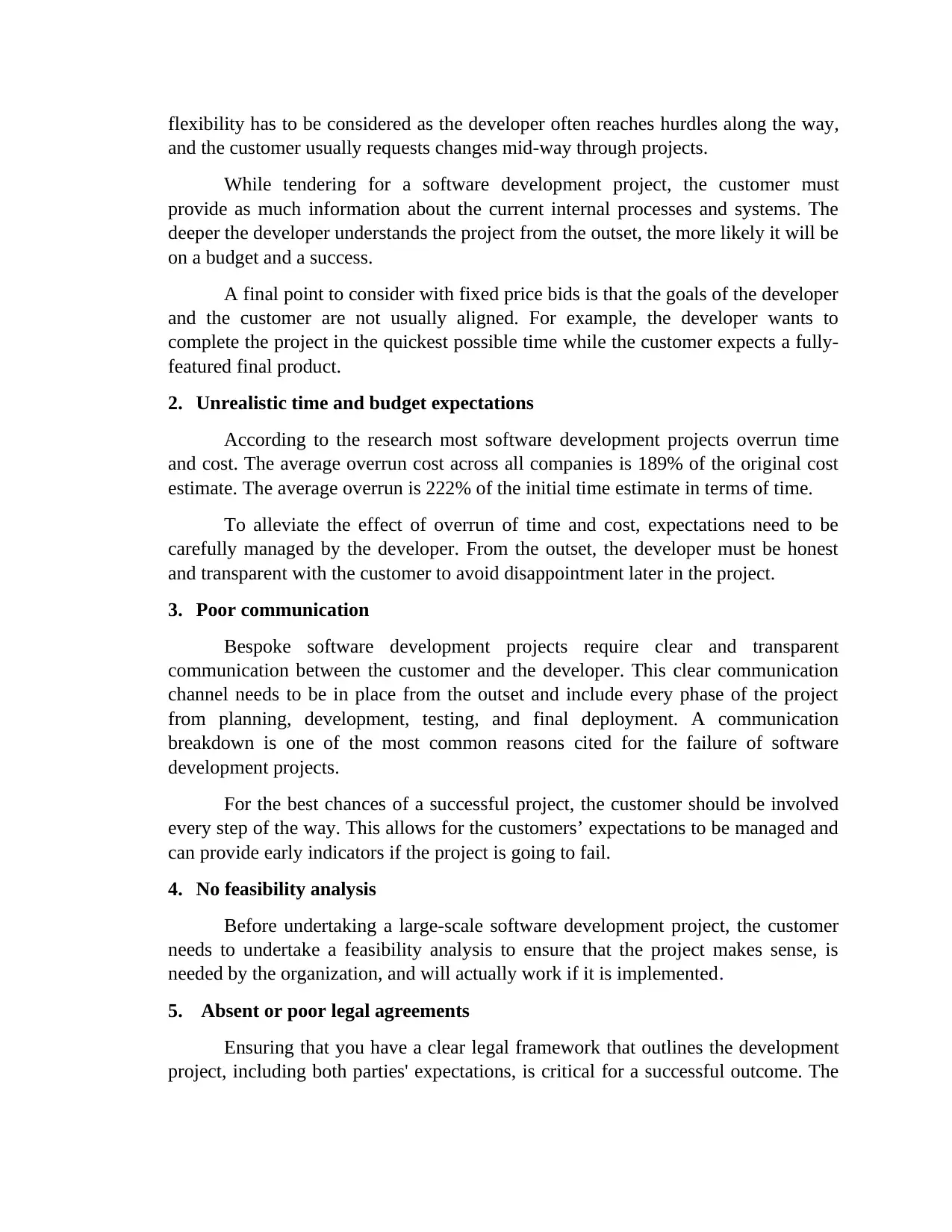
flexibility has to be considered as the developer often reaches hurdles along the way,
and the customer usually requests changes mid-way through projects.
While tendering for a software development project, the customer must
provide as much information about the current internal processes and systems. The
deeper the developer understands the project from the outset, the more likely it will be
on a budget and a success.
A final point to consider with fixed price bids is that the goals of the developer
and the customer are not usually aligned. For example, the developer wants to
complete the project in the quickest possible time while the customer expects a fully-
featured final product.
2. Unrealistic time and budget expectations
According to the research most software development projects overrun time
and cost. The average overrun cost across all companies is 189% of the original cost
estimate. The average overrun is 222% of the initial time estimate in terms of time.
To alleviate the effect of overrun of time and cost, expectations need to be
carefully managed by the developer. From the outset, the developer must be honest
and transparent with the customer to avoid disappointment later in the project.
3. Poor communication
Bespoke software development projects require clear and transparent
communication between the customer and the developer. This clear communication
channel needs to be in place from the outset and include every phase of the project
from planning, development, testing, and final deployment. A communication
breakdown is one of the most common reasons cited for the failure of software
development projects.
For the best chances of a successful project, the customer should be involved
every step of the way. This allows for the customers’ expectations to be managed and
can provide early indicators if the project is going to fail.
4. No feasibility analysis
Before undertaking a large-scale software development project, the customer
needs to undertake a feasibility analysis to ensure that the project makes sense, is
needed by the organization, and will actually work if it is implemented.
5. Absent or poor legal agreements
Ensuring that you have a clear legal framework that outlines the development
project, including both parties' expectations, is critical for a successful outcome. The
and the customer usually requests changes mid-way through projects.
While tendering for a software development project, the customer must
provide as much information about the current internal processes and systems. The
deeper the developer understands the project from the outset, the more likely it will be
on a budget and a success.
A final point to consider with fixed price bids is that the goals of the developer
and the customer are not usually aligned. For example, the developer wants to
complete the project in the quickest possible time while the customer expects a fully-
featured final product.
2. Unrealistic time and budget expectations
According to the research most software development projects overrun time
and cost. The average overrun cost across all companies is 189% of the original cost
estimate. The average overrun is 222% of the initial time estimate in terms of time.
To alleviate the effect of overrun of time and cost, expectations need to be
carefully managed by the developer. From the outset, the developer must be honest
and transparent with the customer to avoid disappointment later in the project.
3. Poor communication
Bespoke software development projects require clear and transparent
communication between the customer and the developer. This clear communication
channel needs to be in place from the outset and include every phase of the project
from planning, development, testing, and final deployment. A communication
breakdown is one of the most common reasons cited for the failure of software
development projects.
For the best chances of a successful project, the customer should be involved
every step of the way. This allows for the customers’ expectations to be managed and
can provide early indicators if the project is going to fail.
4. No feasibility analysis
Before undertaking a large-scale software development project, the customer
needs to undertake a feasibility analysis to ensure that the project makes sense, is
needed by the organization, and will actually work if it is implemented.
5. Absent or poor legal agreements
Ensuring that you have a clear legal framework that outlines the development
project, including both parties' expectations, is critical for a successful outcome. The
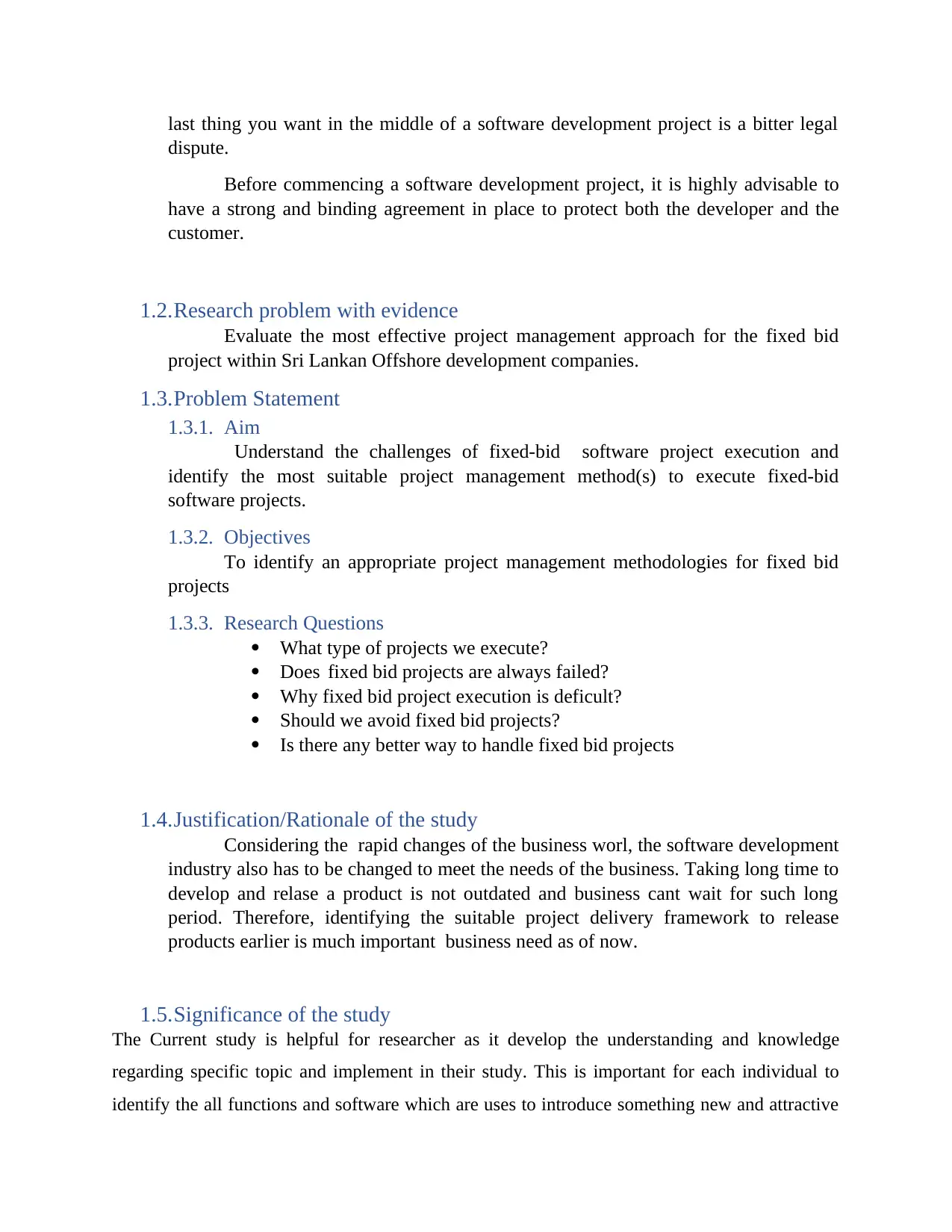
last thing you want in the middle of a software development project is a bitter legal
dispute.
Before commencing a software development project, it is highly advisable to
have a strong and binding agreement in place to protect both the developer and the
customer.
1.2.Research problem with evidence
Evaluate the most effective project management approach for the fixed bid
project within Sri Lankan Offshore development companies.
1.3.Problem Statement
1.3.1. Aim
Understand the challenges of fixed-bid software project execution and
identify the most suitable project management method(s) to execute fixed-bid
software projects.
1.3.2. Objectives
To identify an appropriate project management methodologies for fixed bid
projects
1.3.3. Research Questions
What type of projects we execute?
Does fixed bid projects are always failed?
Why fixed bid project execution is deficult?
Should we avoid fixed bid projects?
Is there any better way to handle fixed bid projects
1.4.Justification/Rationale of the study
Considering the rapid changes of the business worl, the software development
industry also has to be changed to meet the needs of the business. Taking long time to
develop and relase a product is not outdated and business cant wait for such long
period. Therefore, identifying the suitable project delivery framework to release
products earlier is much important business need as of now.
1.5.Significance of the study
The Current study is helpful for researcher as it develop the understanding and knowledge
regarding specific topic and implement in their study. This is important for each individual to
identify the all functions and software which are uses to introduce something new and attractive
dispute.
Before commencing a software development project, it is highly advisable to
have a strong and binding agreement in place to protect both the developer and the
customer.
1.2.Research problem with evidence
Evaluate the most effective project management approach for the fixed bid
project within Sri Lankan Offshore development companies.
1.3.Problem Statement
1.3.1. Aim
Understand the challenges of fixed-bid software project execution and
identify the most suitable project management method(s) to execute fixed-bid
software projects.
1.3.2. Objectives
To identify an appropriate project management methodologies for fixed bid
projects
1.3.3. Research Questions
What type of projects we execute?
Does fixed bid projects are always failed?
Why fixed bid project execution is deficult?
Should we avoid fixed bid projects?
Is there any better way to handle fixed bid projects
1.4.Justification/Rationale of the study
Considering the rapid changes of the business worl, the software development
industry also has to be changed to meet the needs of the business. Taking long time to
develop and relase a product is not outdated and business cant wait for such long
period. Therefore, identifying the suitable project delivery framework to release
products earlier is much important business need as of now.
1.5.Significance of the study
The Current study is helpful for researcher as it develop the understanding and knowledge
regarding specific topic and implement in their study. This is important for each individual to
identify the all functions and software which are uses to introduce something new and attractive
⊘ This is a preview!⊘
Do you want full access?
Subscribe today to unlock all pages.

Trusted by 1+ million students worldwide
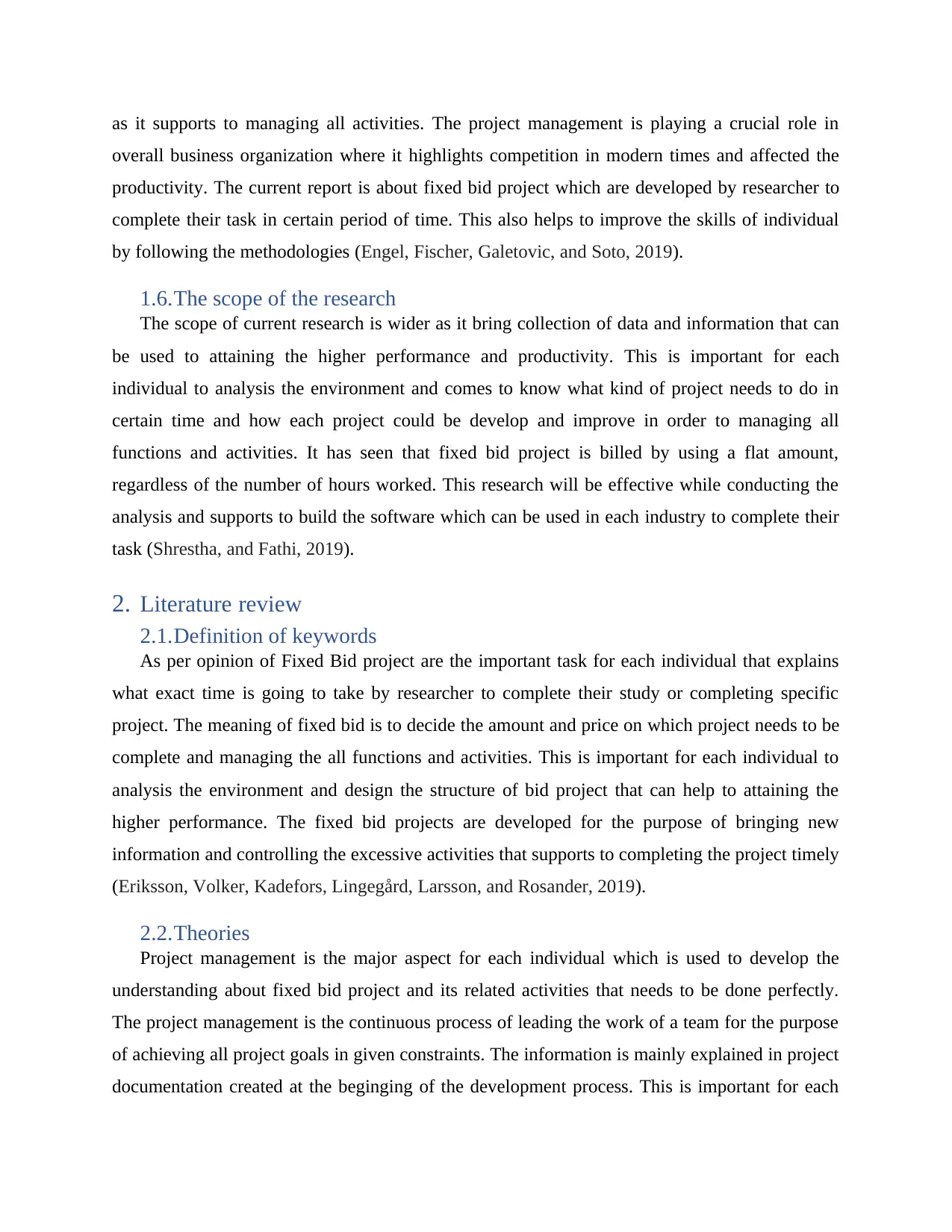
as it supports to managing all activities. The project management is playing a crucial role in
overall business organization where it highlights competition in modern times and affected the
productivity. The current report is about fixed bid project which are developed by researcher to
complete their task in certain period of time. This also helps to improve the skills of individual
by following the methodologies (Engel, Fischer, Galetovic, and Soto, 2019).
1.6.The scope of the research
The scope of current research is wider as it bring collection of data and information that can
be used to attaining the higher performance and productivity. This is important for each
individual to analysis the environment and comes to know what kind of project needs to do in
certain time and how each project could be develop and improve in order to managing all
functions and activities. It has seen that fixed bid project is billed by using a flat amount,
regardless of the number of hours worked. This research will be effective while conducting the
analysis and supports to build the software which can be used in each industry to complete their
task (Shrestha, and Fathi, 2019).
2. Literature review
2.1.Definition of keywords
As per opinion of Fixed Bid project are the important task for each individual that explains
what exact time is going to take by researcher to complete their study or completing specific
project. The meaning of fixed bid is to decide the amount and price on which project needs to be
complete and managing the all functions and activities. This is important for each individual to
analysis the environment and design the structure of bid project that can help to attaining the
higher performance. The fixed bid projects are developed for the purpose of bringing new
information and controlling the excessive activities that supports to completing the project timely
(Eriksson, Volker, Kadefors, Lingegård, Larsson, and Rosander, 2019).
2.2.Theories
Project management is the major aspect for each individual which is used to develop the
understanding about fixed bid project and its related activities that needs to be done perfectly.
The project management is the continuous process of leading the work of a team for the purpose
of achieving all project goals in given constraints. The information is mainly explained in project
documentation created at the beginging of the development process. This is important for each
overall business organization where it highlights competition in modern times and affected the
productivity. The current report is about fixed bid project which are developed by researcher to
complete their task in certain period of time. This also helps to improve the skills of individual
by following the methodologies (Engel, Fischer, Galetovic, and Soto, 2019).
1.6.The scope of the research
The scope of current research is wider as it bring collection of data and information that can
be used to attaining the higher performance and productivity. This is important for each
individual to analysis the environment and comes to know what kind of project needs to do in
certain time and how each project could be develop and improve in order to managing all
functions and activities. It has seen that fixed bid project is billed by using a flat amount,
regardless of the number of hours worked. This research will be effective while conducting the
analysis and supports to build the software which can be used in each industry to complete their
task (Shrestha, and Fathi, 2019).
2. Literature review
2.1.Definition of keywords
As per opinion of Fixed Bid project are the important task for each individual that explains
what exact time is going to take by researcher to complete their study or completing specific
project. The meaning of fixed bid is to decide the amount and price on which project needs to be
complete and managing the all functions and activities. This is important for each individual to
analysis the environment and design the structure of bid project that can help to attaining the
higher performance. The fixed bid projects are developed for the purpose of bringing new
information and controlling the excessive activities that supports to completing the project timely
(Eriksson, Volker, Kadefors, Lingegård, Larsson, and Rosander, 2019).
2.2.Theories
Project management is the major aspect for each individual which is used to develop the
understanding about fixed bid project and its related activities that needs to be done perfectly.
The project management is the continuous process of leading the work of a team for the purpose
of achieving all project goals in given constraints. The information is mainly explained in project
documentation created at the beginging of the development process. This is important for each
Paraphrase This Document
Need a fresh take? Get an instant paraphrase of this document with our AI Paraphraser
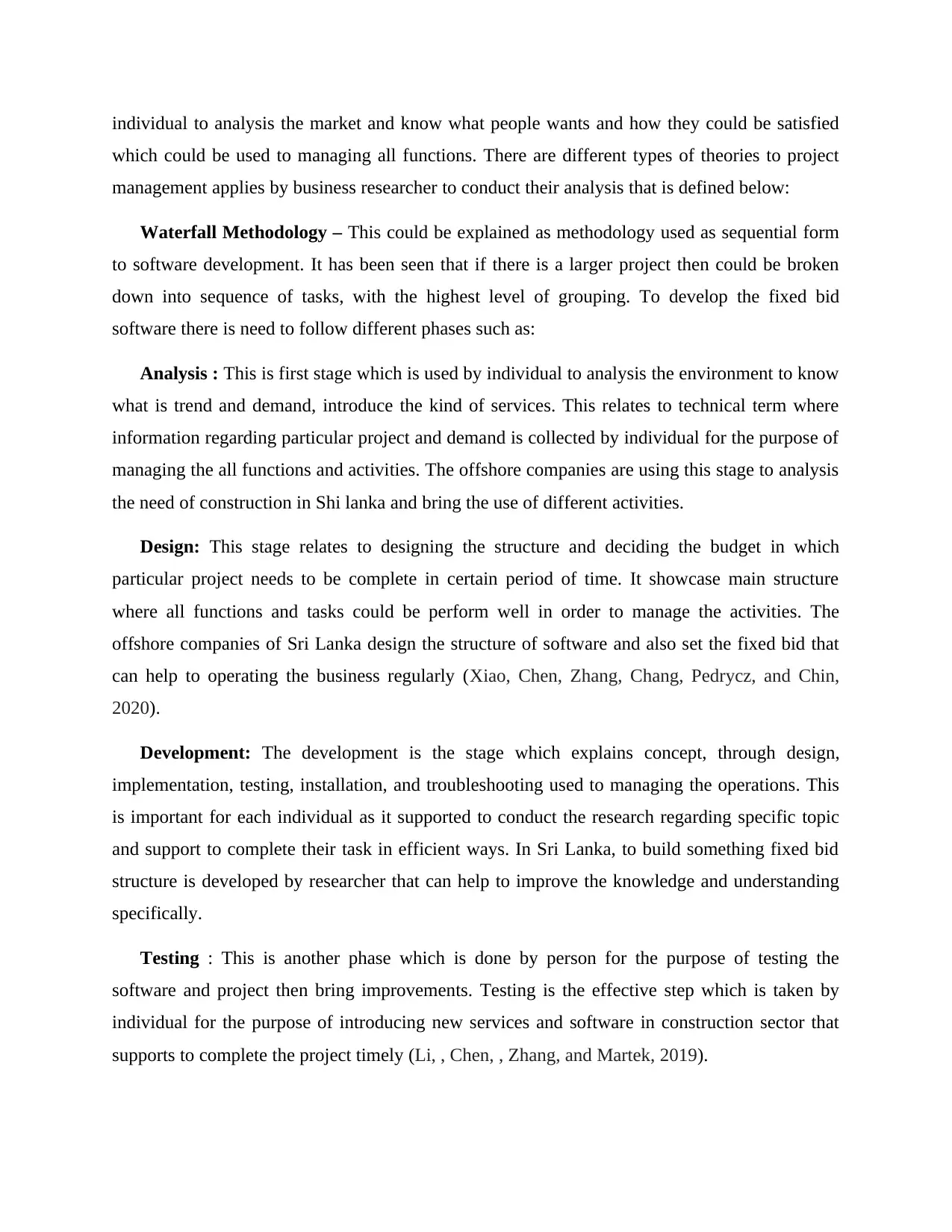
individual to analysis the market and know what people wants and how they could be satisfied
which could be used to managing all functions. There are different types of theories to project
management applies by business researcher to conduct their analysis that is defined below:
Waterfall Methodology – This could be explained as methodology used as sequential form
to software development. It has been seen that if there is a larger project then could be broken
down into sequence of tasks, with the highest level of grouping. To develop the fixed bid
software there is need to follow different phases such as:
Analysis : This is first stage which is used by individual to analysis the environment to know
what is trend and demand, introduce the kind of services. This relates to technical term where
information regarding particular project and demand is collected by individual for the purpose of
managing the all functions and activities. The offshore companies are using this stage to analysis
the need of construction in Shi lanka and bring the use of different activities.
Design: This stage relates to designing the structure and deciding the budget in which
particular project needs to be complete in certain period of time. It showcase main structure
where all functions and tasks could be perform well in order to manage the activities. The
offshore companies of Sri Lanka design the structure of software and also set the fixed bid that
can help to operating the business regularly (Xiao, Chen, Zhang, Chang, Pedrycz, and Chin,
2020).
Development: The development is the stage which explains concept, through design,
implementation, testing, installation, and troubleshooting used to managing the operations. This
is important for each individual as it supported to conduct the research regarding specific topic
and support to complete their task in efficient ways. In Sri Lanka, to build something fixed bid
structure is developed by researcher that can help to improve the knowledge and understanding
specifically.
Testing : This is another phase which is done by person for the purpose of testing the
software and project then bring improvements. Testing is the effective step which is taken by
individual for the purpose of introducing new services and software in construction sector that
supports to complete the project timely (Li, , Chen, , Zhang, and Martek, 2019).
which could be used to managing all functions. There are different types of theories to project
management applies by business researcher to conduct their analysis that is defined below:
Waterfall Methodology – This could be explained as methodology used as sequential form
to software development. It has been seen that if there is a larger project then could be broken
down into sequence of tasks, with the highest level of grouping. To develop the fixed bid
software there is need to follow different phases such as:
Analysis : This is first stage which is used by individual to analysis the environment to know
what is trend and demand, introduce the kind of services. This relates to technical term where
information regarding particular project and demand is collected by individual for the purpose of
managing the all functions and activities. The offshore companies are using this stage to analysis
the need of construction in Shi lanka and bring the use of different activities.
Design: This stage relates to designing the structure and deciding the budget in which
particular project needs to be complete in certain period of time. It showcase main structure
where all functions and tasks could be perform well in order to manage the activities. The
offshore companies of Sri Lanka design the structure of software and also set the fixed bid that
can help to operating the business regularly (Xiao, Chen, Zhang, Chang, Pedrycz, and Chin,
2020).
Development: The development is the stage which explains concept, through design,
implementation, testing, installation, and troubleshooting used to managing the operations. This
is important for each individual as it supported to conduct the research regarding specific topic
and support to complete their task in efficient ways. In Sri Lanka, to build something fixed bid
structure is developed by researcher that can help to improve the knowledge and understanding
specifically.
Testing : This is another phase which is done by person for the purpose of testing the
software and project then bring improvements. Testing is the effective step which is taken by
individual for the purpose of introducing new services and software in construction sector that
supports to complete the project timely (Li, , Chen, , Zhang, and Martek, 2019).
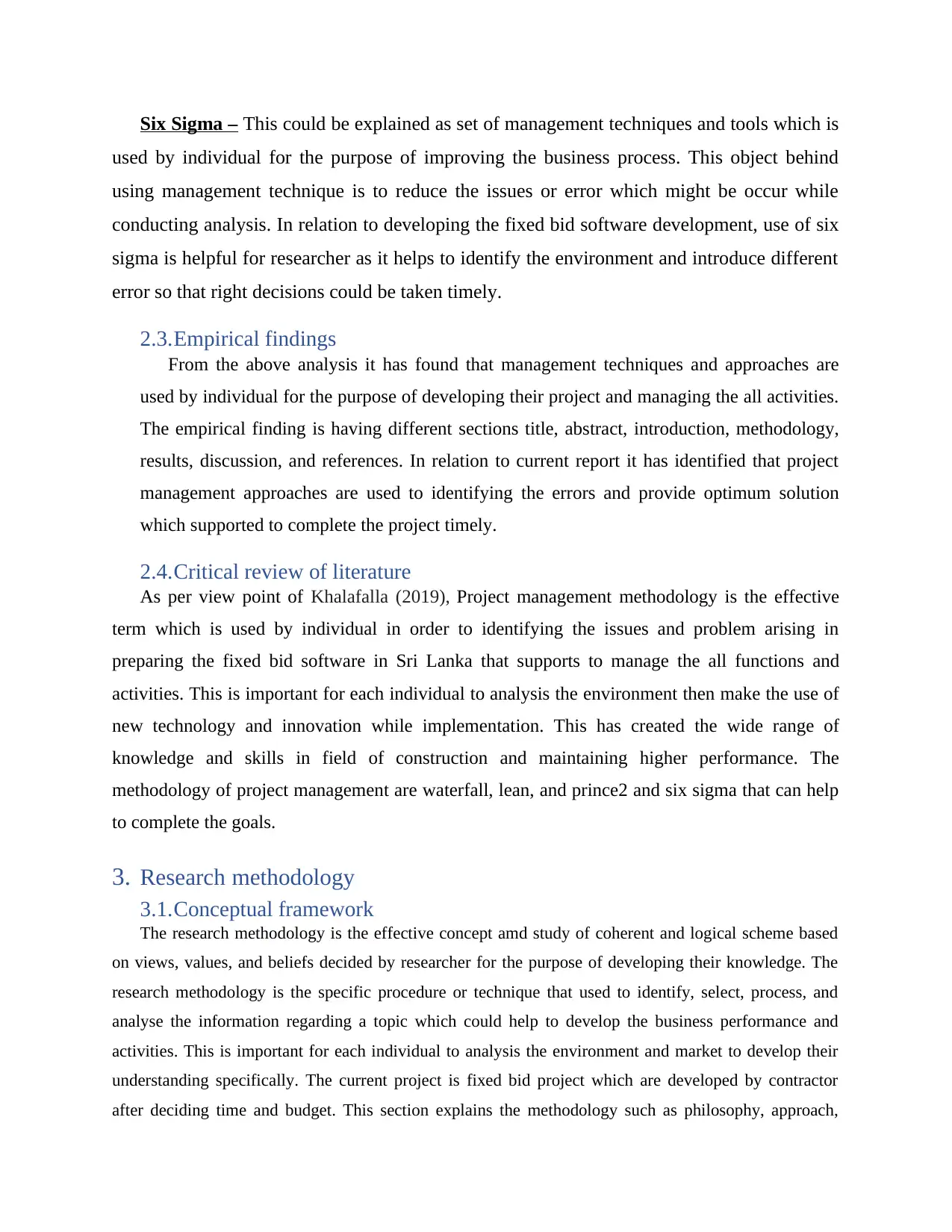
Six Sigma – This could be explained as set of management techniques and tools which is
used by individual for the purpose of improving the business process. This object behind
using management technique is to reduce the issues or error which might be occur while
conducting analysis. In relation to developing the fixed bid software development, use of six
sigma is helpful for researcher as it helps to identify the environment and introduce different
error so that right decisions could be taken timely.
2.3.Empirical findings
From the above analysis it has found that management techniques and approaches are
used by individual for the purpose of developing their project and managing the all activities.
The empirical finding is having different sections title, abstract, introduction, methodology,
results, discussion, and references. In relation to current report it has identified that project
management approaches are used to identifying the errors and provide optimum solution
which supported to complete the project timely.
2.4.Critical review of literature
As per view point of Khalafalla (2019), Project management methodology is the effective
term which is used by individual in order to identifying the issues and problem arising in
preparing the fixed bid software in Sri Lanka that supports to manage the all functions and
activities. This is important for each individual to analysis the environment then make the use of
new technology and innovation while implementation. This has created the wide range of
knowledge and skills in field of construction and maintaining higher performance. The
methodology of project management are waterfall, lean, and prince2 and six sigma that can help
to complete the goals.
3. Research methodology
3.1.Conceptual framework
The research methodology is the effective concept amd study of coherent and logical scheme based
on views, values, and beliefs decided by researcher for the purpose of developing their knowledge. The
research methodology is the specific procedure or technique that used to identify, select, process, and
analyse the information regarding a topic which could help to develop the business performance and
activities. This is important for each individual to analysis the environment and market to develop their
understanding specifically. The current project is fixed bid project which are developed by contractor
after deciding time and budget. This section explains the methodology such as philosophy, approach,
used by individual for the purpose of improving the business process. This object behind
using management technique is to reduce the issues or error which might be occur while
conducting analysis. In relation to developing the fixed bid software development, use of six
sigma is helpful for researcher as it helps to identify the environment and introduce different
error so that right decisions could be taken timely.
2.3.Empirical findings
From the above analysis it has found that management techniques and approaches are
used by individual for the purpose of developing their project and managing the all activities.
The empirical finding is having different sections title, abstract, introduction, methodology,
results, discussion, and references. In relation to current report it has identified that project
management approaches are used to identifying the errors and provide optimum solution
which supported to complete the project timely.
2.4.Critical review of literature
As per view point of Khalafalla (2019), Project management methodology is the effective
term which is used by individual in order to identifying the issues and problem arising in
preparing the fixed bid software in Sri Lanka that supports to manage the all functions and
activities. This is important for each individual to analysis the environment then make the use of
new technology and innovation while implementation. This has created the wide range of
knowledge and skills in field of construction and maintaining higher performance. The
methodology of project management are waterfall, lean, and prince2 and six sigma that can help
to complete the goals.
3. Research methodology
3.1.Conceptual framework
The research methodology is the effective concept amd study of coherent and logical scheme based
on views, values, and beliefs decided by researcher for the purpose of developing their knowledge. The
research methodology is the specific procedure or technique that used to identify, select, process, and
analyse the information regarding a topic which could help to develop the business performance and
activities. This is important for each individual to analysis the environment and market to develop their
understanding specifically. The current project is fixed bid project which are developed by contractor
after deciding time and budget. This section explains the methodology such as philosophy, approach,
⊘ This is a preview!⊘
Do you want full access?
Subscribe today to unlock all pages.

Trusted by 1+ million students worldwide
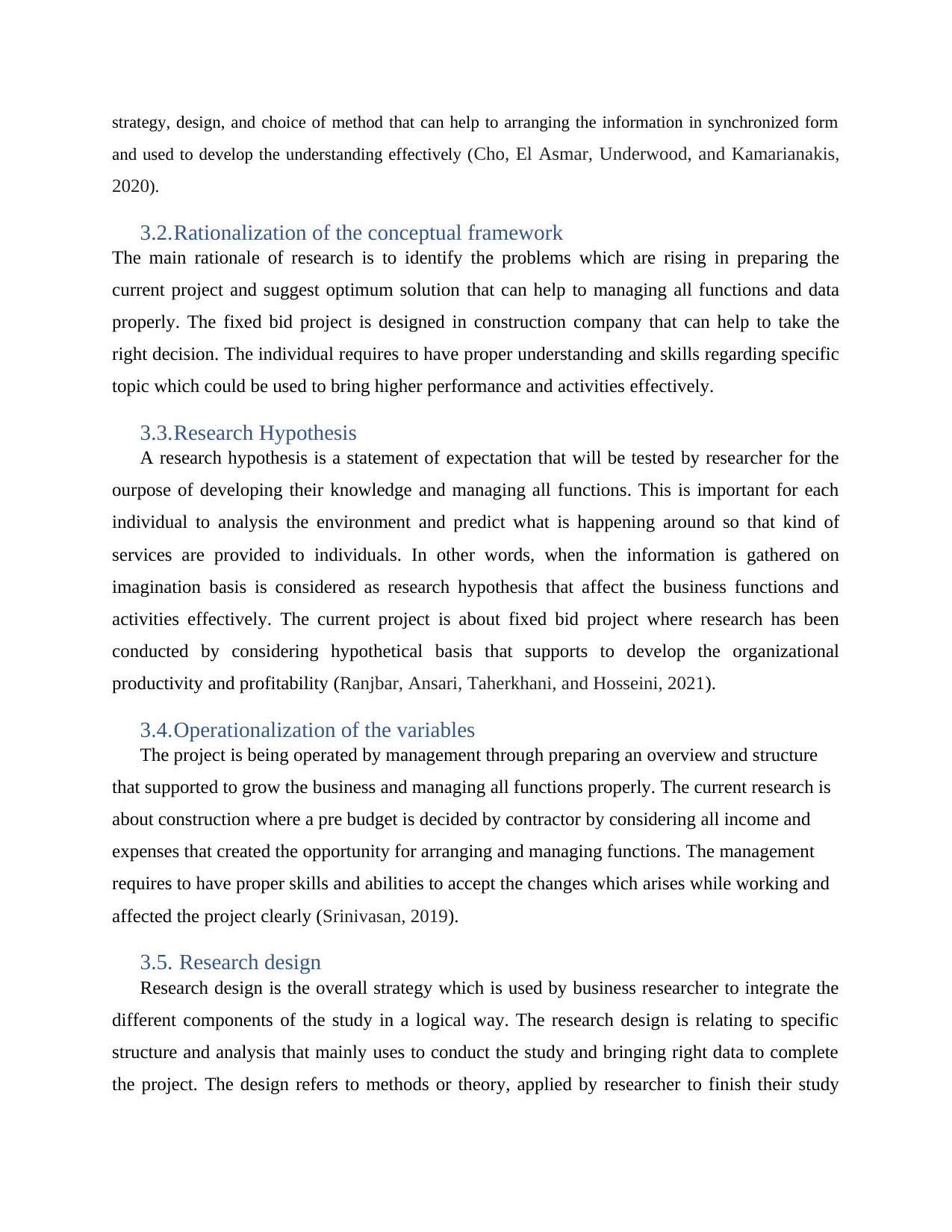
strategy, design, and choice of method that can help to arranging the information in synchronized form
and used to develop the understanding effectively (Cho, El Asmar, Underwood, and Kamarianakis,
2020).
3.2.Rationalization of the conceptual framework
The main rationale of research is to identify the problems which are rising in preparing the
current project and suggest optimum solution that can help to managing all functions and data
properly. The fixed bid project is designed in construction company that can help to take the
right decision. The individual requires to have proper understanding and skills regarding specific
topic which could be used to bring higher performance and activities effectively.
3.3.Research Hypothesis
A research hypothesis is a statement of expectation that will be tested by researcher for the
ourpose of developing their knowledge and managing all functions. This is important for each
individual to analysis the environment and predict what is happening around so that kind of
services are provided to individuals. In other words, when the information is gathered on
imagination basis is considered as research hypothesis that affect the business functions and
activities effectively. The current project is about fixed bid project where research has been
conducted by considering hypothetical basis that supports to develop the organizational
productivity and profitability (Ranjbar, Ansari, Taherkhani, and Hosseini, 2021).
3.4.Operationalization of the variables
The project is being operated by management through preparing an overview and structure
that supported to grow the business and managing all functions properly. The current research is
about construction where a pre budget is decided by contractor by considering all income and
expenses that created the opportunity for arranging and managing functions. The management
requires to have proper skills and abilities to accept the changes which arises while working and
affected the project clearly (Srinivasan, 2019).
3.5. Research design
Research design is the overall strategy which is used by business researcher to integrate the
different components of the study in a logical way. The research design is relating to specific
structure and analysis that mainly uses to conduct the study and bringing right data to complete
the project. The design refers to methods or theory, applied by researcher to finish their study
and used to develop the understanding effectively (Cho, El Asmar, Underwood, and Kamarianakis,
2020).
3.2.Rationalization of the conceptual framework
The main rationale of research is to identify the problems which are rising in preparing the
current project and suggest optimum solution that can help to managing all functions and data
properly. The fixed bid project is designed in construction company that can help to take the
right decision. The individual requires to have proper understanding and skills regarding specific
topic which could be used to bring higher performance and activities effectively.
3.3.Research Hypothesis
A research hypothesis is a statement of expectation that will be tested by researcher for the
ourpose of developing their knowledge and managing all functions. This is important for each
individual to analysis the environment and predict what is happening around so that kind of
services are provided to individuals. In other words, when the information is gathered on
imagination basis is considered as research hypothesis that affect the business functions and
activities effectively. The current project is about fixed bid project where research has been
conducted by considering hypothetical basis that supports to develop the organizational
productivity and profitability (Ranjbar, Ansari, Taherkhani, and Hosseini, 2021).
3.4.Operationalization of the variables
The project is being operated by management through preparing an overview and structure
that supported to grow the business and managing all functions properly. The current research is
about construction where a pre budget is decided by contractor by considering all income and
expenses that created the opportunity for arranging and managing functions. The management
requires to have proper skills and abilities to accept the changes which arises while working and
affected the project clearly (Srinivasan, 2019).
3.5. Research design
Research design is the overall strategy which is used by business researcher to integrate the
different components of the study in a logical way. The research design is relating to specific
structure and analysis that mainly uses to conduct the study and bringing right data to complete
the project. The design refers to methods or theory, applied by researcher to finish their study
Paraphrase This Document
Need a fresh take? Get an instant paraphrase of this document with our AI Paraphraser
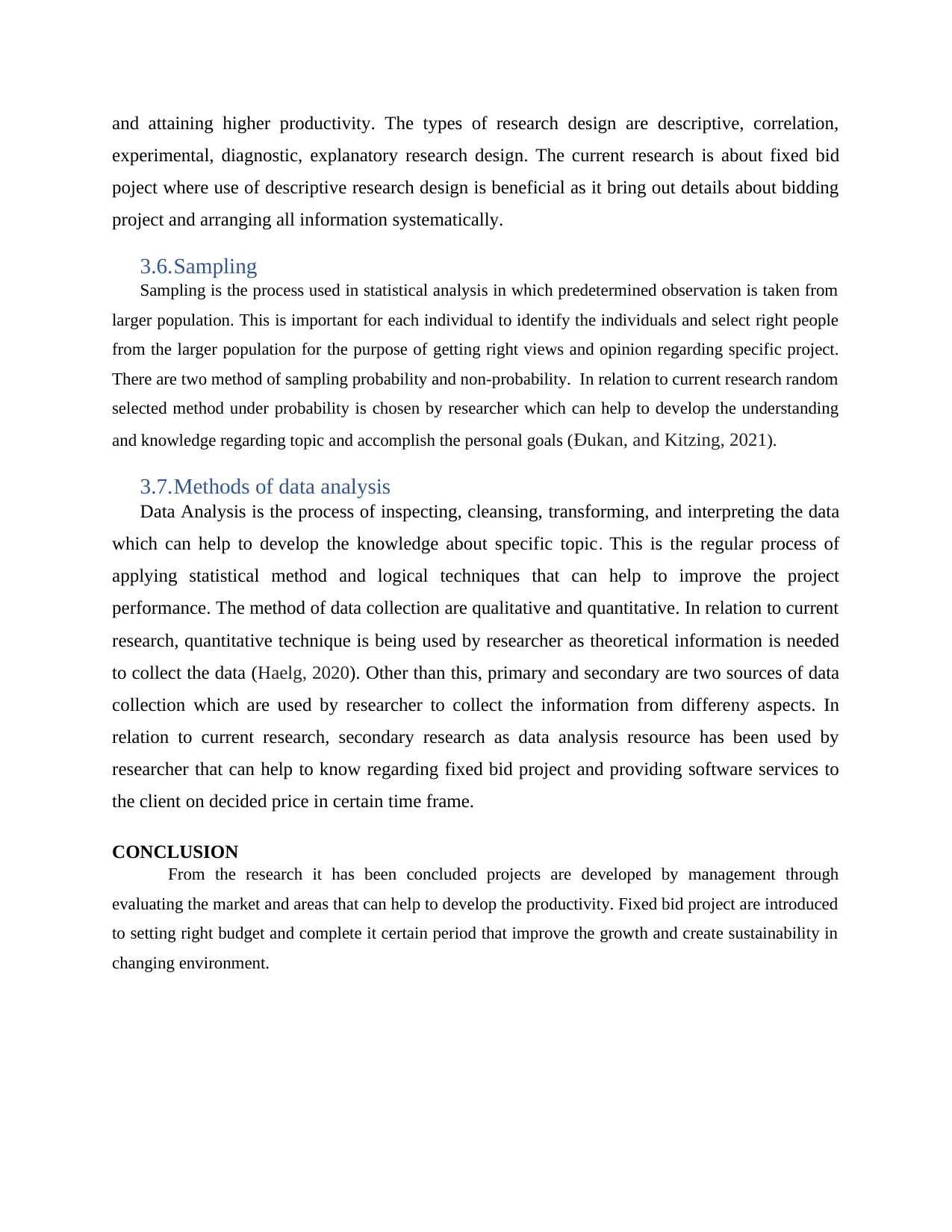
and attaining higher productivity. The types of research design are descriptive, correlation,
experimental, diagnostic, explanatory research design. The current research is about fixed bid
poject where use of descriptive research design is beneficial as it bring out details about bidding
project and arranging all information systematically.
3.6.Sampling
Sampling is the process used in statistical analysis in which predetermined observation is taken from
larger population. This is important for each individual to identify the individuals and select right people
from the larger population for the purpose of getting right views and opinion regarding specific project.
There are two method of sampling probability and non-probability. In relation to current research random
selected method under probability is chosen by researcher which can help to develop the understanding
and knowledge regarding topic and accomplish the personal goals (Đukan, and Kitzing, 2021).
3.7.Methods of data analysis
Data Analysis is the process of inspecting, cleansing, transforming, and interpreting the data
which can help to develop the knowledge about specific topic. This is the regular process of
applying statistical method and logical techniques that can help to improve the project
performance. The method of data collection are qualitative and quantitative. In relation to current
research, quantitative technique is being used by researcher as theoretical information is needed
to collect the data (Haelg, 2020). Other than this, primary and secondary are two sources of data
collection which are used by researcher to collect the information from differeny aspects. In
relation to current research, secondary research as data analysis resource has been used by
researcher that can help to know regarding fixed bid project and providing software services to
the client on decided price in certain time frame.
CONCLUSION
From the research it has been concluded projects are developed by management through
evaluating the market and areas that can help to develop the productivity. Fixed bid project are introduced
to setting right budget and complete it certain period that improve the growth and create sustainability in
changing environment.
experimental, diagnostic, explanatory research design. The current research is about fixed bid
poject where use of descriptive research design is beneficial as it bring out details about bidding
project and arranging all information systematically.
3.6.Sampling
Sampling is the process used in statistical analysis in which predetermined observation is taken from
larger population. This is important for each individual to identify the individuals and select right people
from the larger population for the purpose of getting right views and opinion regarding specific project.
There are two method of sampling probability and non-probability. In relation to current research random
selected method under probability is chosen by researcher which can help to develop the understanding
and knowledge regarding topic and accomplish the personal goals (Đukan, and Kitzing, 2021).
3.7.Methods of data analysis
Data Analysis is the process of inspecting, cleansing, transforming, and interpreting the data
which can help to develop the knowledge about specific topic. This is the regular process of
applying statistical method and logical techniques that can help to improve the project
performance. The method of data collection are qualitative and quantitative. In relation to current
research, quantitative technique is being used by researcher as theoretical information is needed
to collect the data (Haelg, 2020). Other than this, primary and secondary are two sources of data
collection which are used by researcher to collect the information from differeny aspects. In
relation to current research, secondary research as data analysis resource has been used by
researcher that can help to know regarding fixed bid project and providing software services to
the client on decided price in certain time frame.
CONCLUSION
From the research it has been concluded projects are developed by management through
evaluating the market and areas that can help to develop the productivity. Fixed bid project are introduced
to setting right budget and complete it certain period that improve the growth and create sustainability in
changing environment.
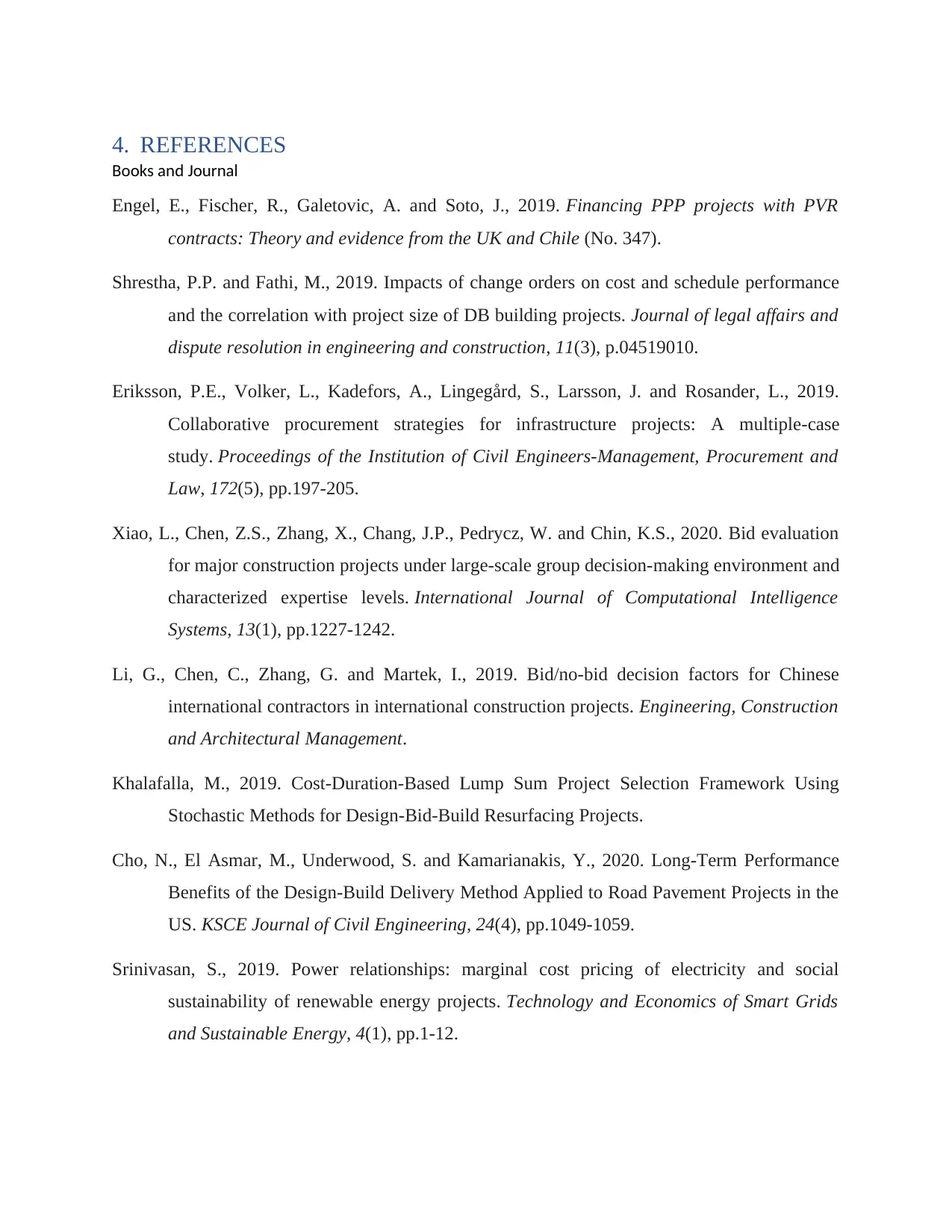
4. REFERENCES
Books and Journal
Engel, E., Fischer, R., Galetovic, A. and Soto, J., 2019. Financing PPP projects with PVR
contracts: Theory and evidence from the UK and Chile (No. 347).
Shrestha, P.P. and Fathi, M., 2019. Impacts of change orders on cost and schedule performance
and the correlation with project size of DB building projects. Journal of legal affairs and
dispute resolution in engineering and construction, 11(3), p.04519010.
Eriksson, P.E., Volker, L., Kadefors, A., Lingegård, S., Larsson, J. and Rosander, L., 2019.
Collaborative procurement strategies for infrastructure projects: A multiple-case
study. Proceedings of the Institution of Civil Engineers-Management, Procurement and
Law, 172(5), pp.197-205.
Xiao, L., Chen, Z.S., Zhang, X., Chang, J.P., Pedrycz, W. and Chin, K.S., 2020. Bid evaluation
for major construction projects under large-scale group decision-making environment and
characterized expertise levels. International Journal of Computational Intelligence
Systems, 13(1), pp.1227-1242.
Li, G., Chen, C., Zhang, G. and Martek, I., 2019. Bid/no-bid decision factors for Chinese
international contractors in international construction projects. Engineering, Construction
and Architectural Management.
Khalafalla, M., 2019. Cost-Duration-Based Lump Sum Project Selection Framework Using
Stochastic Methods for Design-Bid-Build Resurfacing Projects.
Cho, N., El Asmar, M., Underwood, S. and Kamarianakis, Y., 2020. Long-Term Performance
Benefits of the Design-Build Delivery Method Applied to Road Pavement Projects in the
US. KSCE Journal of Civil Engineering, 24(4), pp.1049-1059.
Srinivasan, S., 2019. Power relationships: marginal cost pricing of electricity and social
sustainability of renewable energy projects. Technology and Economics of Smart Grids
and Sustainable Energy, 4(1), pp.1-12.
Books and Journal
Engel, E., Fischer, R., Galetovic, A. and Soto, J., 2019. Financing PPP projects with PVR
contracts: Theory and evidence from the UK and Chile (No. 347).
Shrestha, P.P. and Fathi, M., 2019. Impacts of change orders on cost and schedule performance
and the correlation with project size of DB building projects. Journal of legal affairs and
dispute resolution in engineering and construction, 11(3), p.04519010.
Eriksson, P.E., Volker, L., Kadefors, A., Lingegård, S., Larsson, J. and Rosander, L., 2019.
Collaborative procurement strategies for infrastructure projects: A multiple-case
study. Proceedings of the Institution of Civil Engineers-Management, Procurement and
Law, 172(5), pp.197-205.
Xiao, L., Chen, Z.S., Zhang, X., Chang, J.P., Pedrycz, W. and Chin, K.S., 2020. Bid evaluation
for major construction projects under large-scale group decision-making environment and
characterized expertise levels. International Journal of Computational Intelligence
Systems, 13(1), pp.1227-1242.
Li, G., Chen, C., Zhang, G. and Martek, I., 2019. Bid/no-bid decision factors for Chinese
international contractors in international construction projects. Engineering, Construction
and Architectural Management.
Khalafalla, M., 2019. Cost-Duration-Based Lump Sum Project Selection Framework Using
Stochastic Methods for Design-Bid-Build Resurfacing Projects.
Cho, N., El Asmar, M., Underwood, S. and Kamarianakis, Y., 2020. Long-Term Performance
Benefits of the Design-Build Delivery Method Applied to Road Pavement Projects in the
US. KSCE Journal of Civil Engineering, 24(4), pp.1049-1059.
Srinivasan, S., 2019. Power relationships: marginal cost pricing of electricity and social
sustainability of renewable energy projects. Technology and Economics of Smart Grids
and Sustainable Energy, 4(1), pp.1-12.
⊘ This is a preview!⊘
Do you want full access?
Subscribe today to unlock all pages.

Trusted by 1+ million students worldwide
1 out of 13
Your All-in-One AI-Powered Toolkit for Academic Success.
+13062052269
info@desklib.com
Available 24*7 on WhatsApp / Email
![[object Object]](/_next/static/media/star-bottom.7253800d.svg)
Unlock your academic potential
Copyright © 2020–2025 A2Z Services. All Rights Reserved. Developed and managed by ZUCOL.
